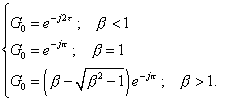V.2 No 1 |
21 |
| Homogeneous 1d resistant line | |
|
|
V.2 No 1 |
21 |
| Homogeneous 1d resistant line | |
|
|
3. Analysis of excitation transmission process in a resistant elastic line The parameters R and |
| (24) |
where Gr is the transfer function for resistant elastic lines. According to (24), the transmission coefficient of each
link is proportional to R2 and the delay caused by each
link – to 2 |
 |
(25) |
In accordance with (11) and (17), both parameters,
|
|
Fig. 1. Delay phase, caused by a member of an elastic line, against the frequency
|
|
Fig. 2. Attenuation degree R2 caused by a member of line, against the frequency of external affection f , at different resistances r |
Contents: / 17 / 18 / 19 / 20 / 21 / 22 / 23 / 24 / 25 / 26 / 27 / 28 / 29 / 30 / 31 / 32 / 33 / 34 /